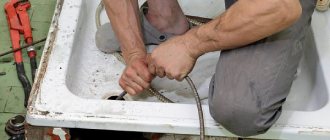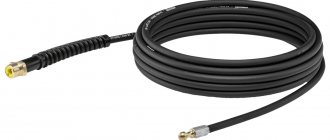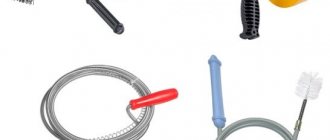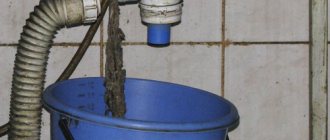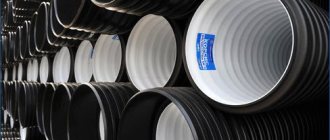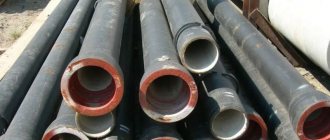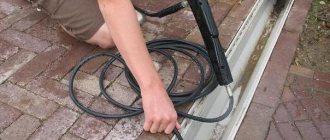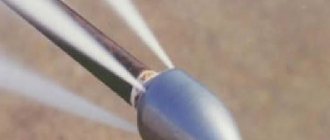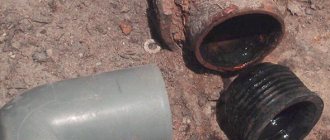Plumbing cable design
Cleaning cable with brush attachment
These plumbing products vary in length, diameter, and type of nozzle. They consist of the following elements:
- rod;
- handles used for rotation;
- nozzle that breaks up the blockage.
The most popular are products 5 meters long, the core of which is made of five strong wires and wrapped with wire in several layers, and the layers are applied in different directions - counterclockwise and clockwise. This device is sufficient for cleaning sewer pipes in an apartment or private house.
Most of the range is made from galvanized hardened steel ST70. This material is at the same time resistant to corrosion, mechanical stress, can withstand up to 3.5 thousand revolutions per minute, and is elastic. The thickness of the zinc layer, wire cross-section and other parameters must comply with GOST standards.
Dependence of cable diameter on wire cross-section
| Rope diameter (mm) | 1-1,2 | 1,4 | 1,6 |
| Wire cross-section (mm) | 1,4 | 1,9 | 2,1 |
The plumbing cable is resistant to twisting. It is used for cleaning:
- sewer and water pipes;
- pipelines fed from boilers and boilers;
- storm drain
The difference between household and professional products is significant. The latter are distinguished by their large diameter and length, the presence of comfortable handles, stands and devices that reduce the required force.
Types of devices for cleaning pipelines
Due to their flexibility and rigidity, cleaning cables are one of the main tools for combating various blockages and contaminants in pipelines for various purposes.
If manually driven spirals are widely used in everyday life for cleaning sewers with their own hands, then in the industrial sector and public utilities powerful machines with an electric or gasoline drive are used, capable of cleaning pipelines of large lengths and sizes.
What kind of blockages can be cleared with the product?
Hose design
Although a drain cleaning cable is considered a universal tool, not all types of clogs can be removed with it.
Operational blockage - consists of small organic deposits arising from fatty deposits, that is, food waste. The cable will clear such a blockage quickly and relatively easily.
Technological blockage - occurs in difficult sections of pipes, for example, on a bend at a large angle or when the diameter of the pipe does not match the purpose of the sewer, or when the diameter in old pipes is narrowed due to lime deposits. You can clear such an area with a cable, but the blockage will form again and again until the cause is eliminated.
Mechanical blockage - the lumen of the pipe is blocked by a large element - a rag, a bag, construction waste. In such cases, a sewer cable will not help much; it is necessary to disassemble the pipe and remove the blockage manually.
Where did the blockage occur?
To choose the right sewer cleaning method, you need to understand where the blockage has formed. To do this, drain the water one by one at all points. If the water does not go somewhere in one place, the siphon is most likely clogged. The second reason is a blockage in the section of the pipe before connecting to the main sewer.
Consequences of a clogged sewer in an apartment
If the water does not leave at all, and even overflows from one device to another (you open the water in the sink, it appears in the bathroom or the level in the toilet begins to rise), the common sewer outlet is clogged.
If we are talking about a private house, this is a branch to a septic tank or cesspool; if we are talking about an apartment, this is the section to the riser or even the sewer riser itself. In the case of a clogged riser in an apartment, there can be an unpleasant situation - when water is drained from the upper floors, due to a blockage in the sewer, it flows into yours and rises in the bathroom or toilet. If the situation is like this, call the plumbers - you can’t handle it on your own, you need powerful equipment.
If the sewage system in a private house is clogged, first of all check whether the pit or septic tank is overflowing. If the level is not above normal, the problem is in the pipes or drains.
Types of plumbing cables
Rope rope
Existing types of cables differ in technical characteristics and features of use.
Rope (rigging) - an affordable device with a diameter of up to 6 mm and a length of 2.5 to 5 m. It looks like a tightly twisted rope made of small wires, the ends of which are crimped so that it does not unfold. But if one of its ends is developed, the product will be even more effective at clearing pipes from simple blockages, the so-called operational ones. The design is elastic and flexible, so it fits well around the bends of the sewer network.
Flexible plumbing cable (also called a flexible shaft) - its basis is a metal rod on which a metal spiral is wound, sometimes in several layers. A handle is attached to one of the ends, which is rotated in one direction when removing the blockage. This breaks down the blockage and pushes it further down the pipe to a wider area. Length – up to 60 m, diameter – up to 28 mm.
The metal tape is a flexible structure designed to break through blockages in large diameter sewer pipes. It is distinguished by the presence of a quadrangular peak at the end. Length – up to 30 m, width – up to 25 mm. When folded, it takes up less space, but is not entirely convenient, since it bends only in one plane.
The spring type is similar to a flexible shaft and consists of a coiled spring. Length – up to 25 m, diameter – up to 13.5 mm. Spring products in a plastic braid are used for cleaning plastic pipes so as not to damage the pipes themselves from the inside, as well as the cavities of the plumbing fixtures.
The tensioner is a professional equipment. It should be used to clear complex blockages when other methods have failed. The products are characterized by increased rigidity, braided metal or vinyl. The handle plays the role of a tensioner, making the cable as rigid as possible. You can optimize the device using different attachments.
Electric is a professional plumbing tool. Such a cable is used where other equipment has failed or is inconvenient to use. They have a handle like a pistol, a drill, a cable wound on a drum, and a set of tips. No need to twist, rotation is automatic.
Spring and rope devices withstand less rotational load compared to other devices, since the rope cable is made of wire of small cross-section, and in a spring product the coils can move relative to the axis.
Types of nozzles
Variety of interchangeable attachments
The attachments vary depending on the purpose. Replaceable ones are installed on a threaded connection and replaced if necessary:
- brush - used to remove organic deposits;
- auger - is a screw attachment resembling a drill, removes soft growths inside the pipe;
- punch or peak - for old and complex blockages that completely cover the lumen of the pipe;
- bottom nozzle – designed to remove construction debris;
- hook - will help you get objects that have fallen into the sewer;
- harpoon - a nozzle that combines the properties of a punch and a hook, simultaneously pierces and picks up the blockage to remove it;
- scraper - designed to remove deposits from pipe walls; it consists of two curved plates with notches.
Less popular attachments:
- in the form of a sphere - for removing sand and lime;
- tetrahedral knife - for removing roots;
- blade - for gypsum and silt deposits.
Any nozzle is selected taking into account the diameter of the pipe: the larger the diameter of the sewer, the larger the diameter of the nozzle should be.
Types of handles
Most plumbing cables for cleaning domestic drains have a rotary handle as a handle. Professional devices are equipped with a plastic or wooden handle, reminiscent of similar elements on a pistol or drill. They are equipped with an electric drive or gearbox that reduces resistance and a stand. All improvements make the process of drain cleaning easier, since the work of removing complex blockages with a long, large-diameter tool is labor-intensive.
The cost of professional devices is much higher than the price of household appliances, so they are used by plumbers who clear blockages every day. In other cases, purchasing expensive equipment is not cost-effective.
Why does the drain get clogged?
- If the sewer system is often clogged, the reason may be a violation of the installation technology or design errors, where building codes and design rules must be strictly observed. Everything has its own tolerances, specified slopes are observed in accordance with design standards, etc.
- The time factor also matters, since if the sewage system is old, then
rust, grease and lime deposits, and so on will form on the internal walls of pipelines, especially cast iron ones. The sewerage system is non-pressure, so we can say that the principle of interdependence applies - the more water passes through the sewerage pipelines, the cleaner it is, since there is no stagnation. - A completely everyday reason - we are simply careless when using sewers, since we do not always use protective mesh to collect waste when washing dishes, and small particles of food, and sometimes large ones, fly into the drain hole. And hair, even if it is long, is generally death when taking water procedures, since it becomes intertwined in strands, clings to the protrusions of the pipes, collecting all sorts of waste and forming plugs.
- Clogs can also be caused by rags, cotton wool or something else accidentally flushed down the toilet. Often, during repairs, the remains of building materials and debris are washed down the drain, which is unacceptable. Before I tell you how to clean a sewer with a cable, we’ll try to do it using simpler methods.
How to choose the right accessory
Plumbing cable - an alternative to chemicals
The type and size of the sewer cleaning cable are selected taking into account the diameter of the pipes and the characteristics of the blockage. The diameter of the cable is directly dependent on the diameter of the pipes:
- to clean pipes up to 50 mm in diameter, use a cable with a diameter of no more than 10 mm;
- for pipes with a diameter of 50-110 mm, a cable of 11-15 mm in diameter is required;
- for pipes more than 110 cm in diameter - a cable with a diameter of more than 16 mm.
Moreover, to clean the sewerage system within an apartment, a tool with a diameter of 6-10 mm is sufficient, for a common one - 12-16 mm, for an industrial one - 16-20 mm.
To clean a small-diameter plastic pipe, use a thin flexible cable with a diameter within a centimeter.
The more turns the sewer system being cleaned has, the thinner the wire from which the cable is made should be.
For cleaning long systems with medium-sized pipes, the diameter of the cable may be slightly larger than recommended, but it is important that it is quite flexible.
Conclusions and useful video on the topic
Several interesting videos will help you choose a tool and tell you how to make a cable with your own hands.
Device for cleaning the sewer system without chemicals:
How you can modify the pipe cleaning cable:
Detailed instructions will help you make a homemade cable:
The mechanical method of cleaning sewers is used only as a last resort, when household chemicals and a plunger are no longer able to help..
Working with a plumbing cable is not a pleasant pastime. Specific sewer dirt is difficult to wash off and is extremely aggressive. But if there is a serious blockage, you cannot do without this flexible shaft. And you don’t even need to call a plumber; you can clean a clogged pipe yourself.
Do you have experience dealing with sewer clogs? Please share information with our readers and suggest your way to solve the problem. You can leave comments in the form below.
How to make a cable with your own hands
The base is made of flexible twisted wire. Thick wire is not used, as it bends poorly. To make it easier to remove the blockage, the tip of the wire is flattened with a hammer or fluffed. The opposite end is bent into a ring to make it convenient to hold. A homemade device is used to clean sewers 3-5 m long.
Another option is a gas flexible hose. A nozzle is attached to one end with a reliable connection so that it does not unscrew during the process and does not remain inside the pipe.
The third option is a steel cable. All you need to do is select a piece of the required length and fluff the tip like a brush. And so that it does not unravel where it is not necessary, at some distance from the end it is fastened with a metal wire clamp.
The fourth option is a device made from a plastic bottle. It is cut in a spiral, creating a long ribbon. It is cut along the edges, making many small notches that will effectively clean the walls of the pipe.
Homemade cable from scrap materials
You can buy the device at any plumbing store, even if you don’t know what the cable is called. But a thrifty owner will try to make such a simple mechanism on his own, and there is nothing complicated about it. In terms of efficiency, a homemade mechanism will be exactly the same as a factory one.
The sequence of actions when making a sewer cleaning mechanism with your own hands:
- For the main body of the device, you can take any wire or cable with a diameter of no more than 9 mm;
- If it is a wire, then its end can be bent into a hook, making the device more versatile. The end of the cable is fluffed up, the end of the cord is equipped with an appropriate nozzle;
- The second end of the wire is bent into the form of a handle for rotation, or in the shape of a ring - this is also convenient for holding the device. For a cable or cord, the handle is made from the same wire or small diameter tube, riveting it together.
A homemade mechanism for cleaning sewer pipes is ready. The basic rule that must be followed when manufacturing a mechanism is that there should be no mechanical defects or cracks. Work with the device with both hands (be sure to wear rubber or, better yet, canvas gloves) so that its position can be adjusted.
Such a home-made device is quite comparable in reliability, efficiency and performance results to professional devices. A cable, wire or cord can be used to remove almost any household blockages in an autonomous sewer system - external or internal. The household device will not take up much space, but it will be very useful at the right time, and your sewer system will work uninterruptedly for a long time.
How to clean a pipe
Using a plumbing cable
Most often, a blockage occurs in the siphon, so before using the cable, first unscrew the siphon and wash it. This will solve the problem in most cases.
Before starting work, inspect the cable for clearing a clogged drain for damage, since a piece of tool stuck in the pipe will only aggravate the problem. In addition, it is recommended to lubricate the rotating elements.
Next, proceed according to the following instructions:
- An oilcloth is laid on the floor. Put rubber gloves on your hands.
- After unscrewing the siphon and removing the sealing plug from the outlet pipe, the end of the cable with the nozzle on it is lowered into the drain of the sink, bathtub or toilet.
- The tool is pushed deeper and deeper by pushing it with one hand and turning the handle clockwise with the other. The tool is gradually unwound. When the cable encounters a blockage, it will be more difficult to turn it, but the speed will increase. In difficult cases, the cable is removed from the pipe, cleaned and lowered into the pipe again, continuing to break through the blockage with jerking movements.
- When the plug is removed, rotation will immediately become easier.
- After removing the blockage, rotate the handle for some time to get rid of the blockage completely. This will not allow it to settle in a new place and will completely destroy it.
- At the end, flushing the drain with hot water is necessary to completely remove any remaining blockage.
After making sure that the problem has been resolved, the siphon is installed in place, and the cable is put away for storage.
Drain cleaning options
Cleaning with a plunger
If such a problem occurs, then, first of all, you need to find out the reason. We check all devices for drainage. If this is a local problem, then you can try to break the plug with a plunger. I think everyone knows this method.
The only thing is, do not forget to close the overflow hole during cleaning. Pour water into the washbasin, sink or bathtub and use “up” and “down” movements to clean it. Pressure is created in the system, which helps to shift the clogged area.
If there is a clog in the kitchen, you may want to try using hot water to dissolve the grease. We take a little washing powder and pour it into the hole - it breaks down grease perfectly, plus we pour hot water, and if we also use a plunger, we get 2 in 1.
Using soda (technical or baking soda) and table vinegar may help. Pour 50-100 grams of soda into the hole in the device and then 150-200 grams of vinegar. A chemical reaction occurs that cleans the pipes. All that remains is to rinse them well.
Chemicals
Today there are many chemical preparations for these purposes - “Mr. Muscle”, “Mole”, “Tiret” and others. We try them according to the instructions. We follow safety precautions, as the drugs contain aggressive components.
When all attempts are in vain, we begin examining the siphon of the washbasin and bathtub. Unscrew the plastic cover from the bottom (sump) and remove the dirt. I will write a more detailed article about how to clean the siphon, their structure and purpose, since they are also found in cast iron. I suggest you read the article purchasing plumbing fixtures in order to choose the right plumbing fixtures.
Tips and tricks
Useful tips will help you clean the drain efficiently and keep your tool in good condition for a long time:
- After use, the cable must be washed, dried well, lubricated with technical oil and put into a paper bag or wrapped in paper, rolling the tool into a coil. It is not recommended to store it in a sealed plastic bag.
- When cleaning the sewer, hold the shaft with the other hand, controlling the progress of the work.
- When flushing the drain after removing the blockage, you can add a degreaser to the water.
If the water forms a funnel when draining, it means that the sewer has been cleaned efficiently.
Comparison with other devices
Depending on the complexity of the blockage, the simplest devices (for example, a plunger) or mechanisms equipped with a mechanical or electrical unit that rotates the nozzle can be effective. After eliminating the accident, the device must be thoroughly rinsed and dried.
Brush for cleaning sewer pipes
The brush brush delicately removes blockages without scratching the pipe cavity, and is most suitable for cleaning kitchen sink siphons. Available in the following versions:
- a polymer brush is located at the end of a flexible cable made of corrosion-resistant steel with a diameter of 5.5 mm, the length of the product is 1.2 m;
- a flexible cable 80 cm long (with a handle) is 3/4 covered with polymer bristles that clean out grease deposits well.
Flexible shaft for drain cleaning
The flexible shaft is designed to remove complex blockages and is classified as professional equipment. It consists of a steel cable with a diameter of 9 mm and a braid - a tightly wound spiral of steel wire. The shaft diameter can be 13.5, 16 and 30 mm, the cable length can be up to 60 m.
When the handle is turned during operation, the tool becomes as rigid as a steel rod, so it is used for cleaning sewer risers and horizontal pipes.
Karcher hose for sewerage
At the front end of the hose there is a short brass nozzle (thread for nozzle R 1/8″), which forms 4 high-pressure jets directed backwards. Due to this, it moves through the pipe and removes blockages. The hose for cleaning sewer pipes is flexible and elastic, reinforced with a textile braid that protects against kinks. Cleaning occurs due to high pressure. Progress is ensured by the design of the nozzle and is monitored by marks on the hose.
Electrical devices
An electric sewer pipe cleaning machine consists of a drive in the form of an electric drill, a feeding device and a cleaning spiral. Some models have a device for drying the coil.
The operation of the machine is based on the translational rotation of a spiral with a tip on. It is lowered into the pipe and driven using an electric drive. Rotating and moving deeper, the spiral reaches the plug, breaks it and pushes it into a wider pipe. The operator can adjust the speed of rotation of the spiral, stop its movement and change direction.
The spiral is packaged in impact-resistant plastic, which is easy to wash after use. Some models (for example, Ridgid) allow you to clear drains of blockages without dismantling grates and siphons.
Electric devices clean sewer pipes from 20 to 250 mm, can be powered by mains or battery, are compact and easy to use.
Selection of working diameter
When purchasing equipment, an important aspect is the choice of the working diameter and length of the tool.
The diameter of the cable is proportional to the diameter of the pipe that needs to be cleaned. For example, a 6mm cable is suitable for pipes with a diameter of 20 to 55mm; 9 mm - from 50 to 76 mm; 12 mm - from 50 to 100 mm.
In everyday life, with a sewerage length of 10 to 25 meters, a spring-wound cable with a diameter of 9 mm is used. With pipes with a diameter of 100 mm, they work with 16 mm equipment between floors with a length of up to 30 meters.
The difference between a handheld tool and a power tool
Using a plumber's cable to clean your drains offers several benefits:
- Safe to use.
- Effective cleaning.
- Use of several types of nozzles.
- Great torque.
- Combination of elasticity and flexibility of the device.
- Simple and convenient to use.
Frequent use of a plumbing cable can lead to rupture of the spiral, but with proper storage and care, including cleaning and oiling after completion of work, the tool can last for quite a long time.
However, despite the simplicity and low cost of a manual cord for cleaning sewer pipes, working with it requires some effort. There are two ways to solve this type of problem. Firstly, there are options for modifying the manual device to a more advanced form. Secondly, you can simply purchase a professional electric tool.
For professional work as a master plumber, a power tool is better suited, as it greatly simplifies the process of cleaning sewer pipes. In addition, professional sewer cleaning cables have a long service life, which is very important for repeated use.
As for one-time work at home, it is better to purchase a simpler and cheaper device for manual sewer cleaning. You should know that there are a lot of special devices that can make the work of a home craftsman easier. These can be handles on a rigid stand, several types of attachments for removing various blockages, and full-fledged electrical devices equipped with a motor.
Additional equipment for cable
If there is little water flow in the bathroom, the sink is clogged, or there is an unpleasant smell in the kitchen that cannot be removed with a freshener, you need to act immediately. With the help of Saniclean you can easily cope with the situation without a plumber... Read more»
In addition to the cable and attachments, you can use additional devices. This will simplify the process of clearing the clog.
Additional equipment may include:
- hand spinner with drum;
- electric machine (twists and winds the cable);
- flexible shells.
Mechanical and electrical appliances significantly make the process of twisting and winding faster and easier. The drum makes it possible not to wind the entire cable, and therefore prevents splashing of dirt.
Electrical devices are more often used by professionals. They are expensive and require special skills.
Which cable to choose
There are a few factors to consider before purchasing a cable.
Namely, focus on the following details:
- The maximum distance from the riser to the siphon. It is not recommended to purchase cables that are too long. The length should be approximately equal to this distance. The maximum height is one metre.
- Pipe diameter. The larger it is, the wider the cable should be. Otherwise, there is a high risk that it will spin.
- Number of pipe bends. For pipes with a large number of turns, cables with a core are not suitable. They bend poorly and are optimal for cleaning horizontal pipes.
It is advisable to choose options that have a handle. And also a tip that makes it possible to install a nozzle. In addition, good models have an external and internal shaft.
You can pay attention to more expensive models: with electrical and mechanical devices for torsion. Such options are more convenient, and working with them is faster and more efficient.
Nozzles for sewer cables
The drain can become clogged with many materials: rags, hair, wool, etc. The accumulation of such debris can create blockages that cannot be removed by standard mechanical intervention. To achieve the desired result, special attachments are used.
The nozzles differ in appearance and purpose:
- “ruff” - allows you to remove plaque from the walls of the pipeline;
- punching - destroy compressed blockages;
- bottom - for the elimination of stone chips and elements of construction waste;
- hook-shaped - they are used to catch and pull out rags and clumps of hair;
- loop-shaped - remove water seals.
Selection of tools by diameter
One of the important criteria for choosing a plumbing cable is its cross-section. It should be remembered that thick tools make cleaning sinks or urinals more difficult; they simply will not be able to fit into the drain hole of the plumbing equipment. Thick tools are used to clear risers and large diameter pipes from blockages.
Experts recommend using the following data when choosing a flexible shaft:
- If the diameter of the pipe does not exceed 5 cm, then the cross-section of the cable for cleaning the sewer should not exceed 1 cm.
- Pipelines with a diameter of 5 to 11 cm are cleaned with a cable whose cross-section is 1.1-1.5 cm.
- It is recommended to clean vertical risers with a diameter of more than 10 cm with a tool with a cross-section of more than 1.6 cm.
When using a cable for cleaning pipes with a cross-section of 3-4 mm, you should be wary of breaks in the process of pulling the plug out of the pipe. It is better to use such devices when cleaning a siphon or removing hair from a drain. To remove blockages in the form of a rag, it is recommended to use a more solid device.
Rope care
Many manufacturers of plumbing cables indicate in the operating instructions that the service life of their products is unlimited, but with improper care it can be significantly reduced, because the material used is corrosion-resistant steel. Plumbing cable is used quite rarely in households, so the main task is to bring it into proper condition for long-term storage after use.
In this case proceed as follows:
- After cleaning procedures, the cable is washed from dirt in hot water with any dishwashing or laundry detergent, using a metal brush or a stiff sponge to remove deposits.
- Since steel is afraid of moisture, the cable should be thoroughly dried to avoid corrosion processes. The drying time should be significantly increased when using spring hollow models inside - water can accumulate in the middle of the cable, which is prevented by tightly fitting spiral turns.
- The outer sheath of the cable is coated with machine oil using a small piece of cloth, then, depending on the design, it is wound onto a drum or twisted into a ring and placed for storage.
Price list for popular models
Causes of sewer blockage
- accumulation of fat. The lion's share of clogs are fatty. The particles accumulate over several years before creating a serious problem. The duration of the accumulation depends on the pipes and installation. Gradually the fat layer thickens. Blockages of this type are persistent and cannot be easily and quickly removed;
- mechanical blockages are less common. The idea is that an object gets into the sewer and blocks the flow of water. Do not allow skin or body care items, as well as food debris, building elements or toy parts to enter the drain;
- system damage. In private buildings the problem occurs frequently. The sewer system is damaged, for example, by tree roots. Wrapping around the pipe, creating deformation of the system;
- installation errors. Sharp, low angles of pipes affect water flow. The presence of turns and bends in a small section of the system. Negligence towards material adhesions. Lack of vent pipes and valves. These errors lead to blockages;
- sewer wear. The system, made of PVC pipes, is strong and durable. No grease sticks to the inner walls of the pipes and there is no corrosion. If the house has cast iron communications, there will be more problems with blockages.
Knowing the reasons, you can protect your own home in advance from the appearance of unpleasant odors in the room and unexpected repairs.
